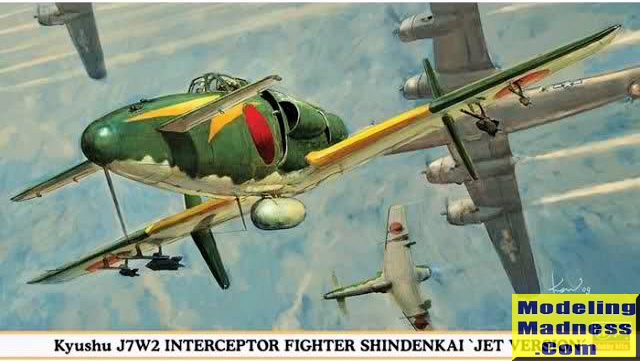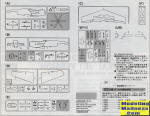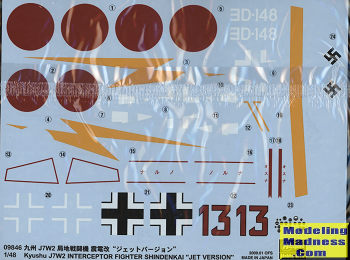
Hasegawa 1/48 J7W2 Shindenkai 'Jet Version'
| KIT #: | 09846 |
| PRICE: | 3800 SRP. A search turned up delivered prices from $42-$200. |
| DECALS: | Two options |
| REVIEWER: | Scott Van Aken |
| NOTES: | 2009 Limited Edition. Resin parts. New sprue. |

| HISTORY |
The Kyūshū J7W1 Shinden (震電, "Magnificent Lightning") fighter was a World War II Japanese propeller-driven aircraft prototype with wings at the rear of the fuselage, a nose mounted canard, and pusher engine.
Developed by the Imperial Japanese Navy (IJN) as a short-range, land-based interceptor, the J7W was a response to Boeing B-29 Superfortress raids on the Japanese home islands. For interception missions, the J7W was to be armed with four forward-firing 30 mm cannons in the nose.
The construction of the first two prototypes started in earnest by June 1944, stress calculations were finished by January 1945, and the first prototype was completed in April 1945. The 2,130 hp Mitsubishi MK9D (Ha-43) radial engine and its supercharger were installed behind the cockpit and drove a six-bladed propeller via an extension shaft. Engine cooling was to be provided by long, narrow, obliquely mounted intakes on the side of the fuselage. It was this configuration that caused cooling problems while running the engine while it was still on the ground. This, together with the unavailability of some equipment parts postponed the first flight of the Shinden.
Even before the first prototype took to the air, the Navy ordered the J7W1 into production, with a quota of 30 Shinden a month given to Kyushu's Zasshonokuma factory and 120 from Nakajima's Handa plant. It was estimated some 1,086 Shinden could be produced between April 1946 and March 1947.
On 3 August 1945, the prototype first flew, with Tsuruno at the controls, from Itazuke Air Base. Two more short flights were made, a total of 45 minutes airborne, one each on the same days as the atomic bombings of Hiroshima and Nagasaki occurred, before the war's end. Flights were successful, but showed a marked torque pull to starboard (due to the powerful engine), some flutter of the propeller blades, and vibration in the extended drive shaft.
The Shinden was expected to be a highly maneuverable interceptor, but only two prototypes were finished before the end of war. A jet engine–powered version was considered, but never reached the drawing board.
| THE KIT |
 I
believe this may well be one of the molds Hasegawa inherited when they bought
Mania in the 1970s. The kit is nicely done with raised panel lines that are
typical of that era. The cockpit is basically a tub into which one places a
seat, stick and rudder pedals as well as a trim wheel. The instrument panel is
placed into the fuselage itself. There is detail on the sidewalls and there is a
roll bar assembly that fits behind the pilot's seat. This along with the nose
gear and some weight is trapped between the two fuselage halves.
I
believe this may well be one of the molds Hasegawa inherited when they bought
Mania in the 1970s. The kit is nicely done with raised panel lines that are
typical of that era. The cockpit is basically a tub into which one places a
seat, stick and rudder pedals as well as a trim wheel. The instrument panel is
placed into the fuselage itself. There is detail on the sidewalls and there is a
roll bar assembly that fits behind the pilot's seat. This along with the nose
gear and some weight is trapped between the two fuselage halves.
Not having built this kit, I'm not sure if the prop version was provided with stores, but this one is and there are various holes one has to open depending on how the aircraft is to be equipped. This has to be done prior to assembling the wing which is a single lower piece and two upper wing halves. The single piece twin tails are then slotted into the back of the wing. For this version, the small castor wheels are removed as those were installed to keep the prop from hitting the ground and this has no prop.
The kit provides three resin parts. One is the jet exhaust which replaces the engine cowling tip and the other two are enlarged intake pieces. The canard and upper nose piece are a single construct and this is where the two cannon barrels are installed. Landing gear are rather spindly, and for those who want something a tad more solid, Scale Aircraft Conversions does a set of metal replacements. The kit also includes a standing pilot figure.
A three piece canopy is provided, though I'm not sure if
it is designed to be displayed open. There are two sprues which I believe are
new to this boxing. At least, I've not seen them on the original Hasegawa or the
Minicraft boxing. This includes a pair of drop tanks and rockets. There are
rails included for the rockets and one can install either two smaller rockets or
one large and one small rocket per wing. One of the tanks can be carried on the
 centerline.
If two wing tanks are carried, the large rockets cannot and only one smaller
rocket will fit, this location outboard of the twin set up. This means that you
need to make your mind up before assembling the wings as to just how you are
going to arrange any underwing stores.
centerline.
If two wing tanks are carried, the large rockets cannot and only one smaller
rocket will fit, this location outboard of the twin set up. This means that you
need to make your mind up before assembling the wings as to just how you are
going to arrange any underwing stores.
Instructions are the usual with Gunze paint references. There are two 'whiffer' schemes. One is the box art from the 302nd Naval Flying Group in 1947 with a big yellow flash on the fuselage, and the other is a Luftwaffe scheme from the same time period. Of course, you can paint this any way you might like and used extra markings from another kit. This is part of the fun of these sorts of kits.
| CONCLUSIONS |
If this sort of thing is something you like, then I'd encourage you to look for one while they are still around. What if models are popular in some circles and one thing for certain is that few of your fellow modelers will have built one. This was also done in 1/72 scale, though that kit is considerably more difficult to find.
| REFERENCES |
https://en.wikipedia.org/wiki/Kyushu_J7W
August 2017
Copyright ModelingMadness.com. All rights reserved.
If you would like your product reviewed fairly and fairly quickly, please contact the editor or see other details in the Note to Contributors.
Back to the Main Page Back to the Review Index Page Back to the Previews Index Page